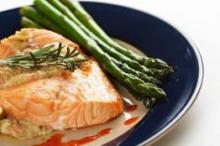The consumption of fish rich in n-3 polyunsaturated fatty acids was inversely related to the risk of developing hepatocellular carcinoma in a population-based study of Japanese adults, Dr. Norie Sawada and colleagues reported in the June issue of Gastroenterology.
In addition, higher intake of several individual n-3 polyunsaturated fatty acids (PUFAs) – particularly eicosapentaenoic acid, docosapentaenoic acid, and docosahexaenoic acid – also correlated with lower hepatocellular carcinoma (HCC) risk.
The associations were dose dependent for intake of n-3 PUFA-rich fish and for intake of individual fatty acids, said Dr. Sawada of the National Cancer Center, Tokyo, and associates.
Dietary n-3 PUFAs, also called omega-3 PUFAs, have long been thought to lower the risk of developing several cancers, but few studies have examined a potential protective effect against liver cancer in particular. One recent prospective study in the United States showed an inverse association between consumption of "white meat," including fish, and liver cancer, but other studies have found no such correlation.
Dr. Sawada and colleagues examined the issue by analyzing data from a large cohort study launched in the 1990s and supervised by the Japanese department of public health. The investigators analyzed detailed dietary data from 90,296 adults who were aged 40-69 years at baseline and were followed for an average of 11 years.
The study subjects completed questionnaires regarding their usual intake of 138 food items during the previous year, using standard portions or units of consumption. Nineteen items on the questionnaire asked about dietary fish and shellfish, which in Japan includes salted fish; dried fish; canned tuna, salmon, or trout; and bonito, tuna, cod, sea bream, mackerel, sardine, mackerel pike, roe, eel, squid, octopus, prawn, clam, crab, vivipara, as well as various fish pastes.
The investigators used the subjects’ responses to calculate daily fish consumption. They also calculated daily intake of all n-3 PUFAS combined, and intake of four individual fatty acids. They separately calculated the consumption of fish rich in n-3 PUFAs, namely salmon, trout, sea bream, mackerel, sardine, mackerel pike, and eel.
Blood samples that had been taken during general health check-ups were screened for hepatitis C antibodies and hepatitis B surface antigen to determine whether the subjects were carrying hepatitis C or B.
A total of 398 cases of incident HCC developed during follow-up (Gastroenterology 2012 Feb. 20 [doi:10.1053/j.gastro.2012.02.018]).
Total fish consumption showed a weak inverse association with risk of HCC, with a multivariable hazard ratio of .64 for highest vs. lowest quintile (95% confidence interval, 0.41 to 1.02, P for trend = .07). The association reached statistical significance when the analysis was confined to fish rich in n-3 PUFAs with a HR of 0.64 (95% CI, .42 to .96, P for trend = .04).
Strong, dose-dependent inverse associations also were found between HCC risk and dietary intake of eicosapentaenoic acid, docosapentaenoic acid, and docosahexaenoic acid.
These results did not change substantially when the data were adjusted to account for subject age, sex, smoking status, and body mass index. The findings also persisted across several subgroups of patients such as alcohol drinkers and coffee drinkers.
The inverse association between consumption of fish high in n-3 PUFAs and HCC risk also was strong in the subgroups of patients positive for hepatitis B or hepatitis C.
The reasons underlying this protective effect against liver cancer are not yet known. It is likely that the anti-inflammatory properties of polyunsaturated fatty acids play a role, "given that HCC is an inflammation-related cancer which has a background of chronic inflammation triggered by exposure to hepatitis virus infection or toxic compounds such as ethanol," Dr. Sawada and associates said.
This study was somewhat limited in that it was necessary to estimate the consumption of fish and individual fatty acids rather than measuring these amounts directly. Also, the dietary data were based on subjects’ self-report at only a single time point.
The study was supported by the National Cancer Center Research and Development Fund and the Ministry of Health, Labor, and Welfare of Japan, both in Tokyo. The authors reported no financial conflicts of interest.


